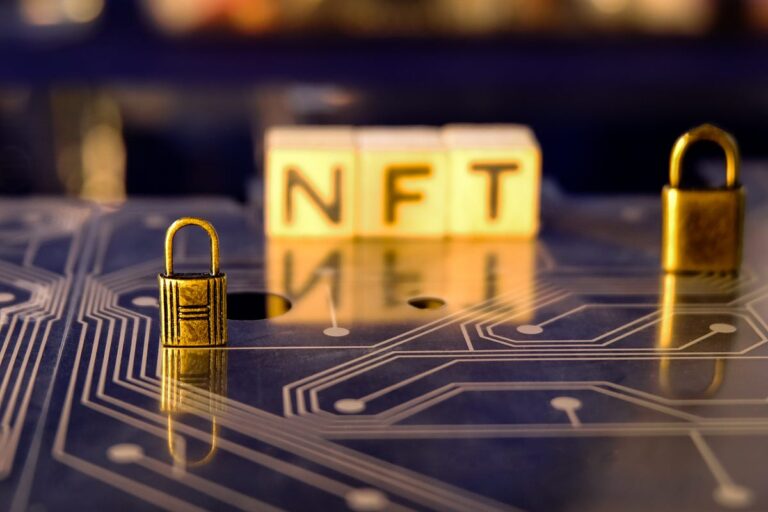The digital revolution has transformed how we create, buy, and sell art, with Non-Fungible Tokens (NFTs) leading this transformation. This comprehensive nft creation and trading guide will walk you through every step of your NFT journey, from understanding the basics to generating substantial profits. Whether you’re an artist looking to monetize your creativity or an investor seeking new opportunities, mastering NFT creation and trading has become essential in today’s digital economy. The NFT market has evolved significantly, offering creators unprecedented control over their intellectual property while providing traders with exciting investment opportunities that didn’t exist just a few years ago.
What Are NFTs and Why Do They Matter
Non-Fungible Tokens represent unique digital assets stored on blockchain networks, primarily Ethereum. Unlike cryptocurrencies such as Bitcoin, each NFT possesses distinct characteristics that make it irreplaceable and valuable. The technology behind NFTs ensures authentic ownership verification, creating scarcity in the digital realm where copying was once effortless.
The significance of NFTs extends beyond mere digital collectibles. They’ve revolutionized creative industries by enabling artists to receive royalties from secondary sales automatically. This paradigm shift has attracted millions of creators worldwide, from digital artists and musicians to game developers and content creators.
Understanding NFTs requires grasping their underlying blockchain technology. Smart contracts govern NFT behavior, defining ownership rules, transfer conditions, and royalty distributions. These self-executing contracts eliminate intermediaries, reducing costs while ensuring transparent transactions.
The NFT ecosystem encompasses various categories, including art, music, gaming assets, virtual real estate, domain names, and utility tokens. Each category serves different purposes and attracts distinct audiences, creating diverse opportunities for creators and traders alike.
Getting Started with NFT Creation
Choosing Your Creative Direction
Successful NFT creation begins with identifying your unique artistic voice and target audience. Digital art remains the most popular category, encompassing photography, illustrations, 3D models, and animated content. Musicians create audio NFTs, while game developers mint in-game assets and characters.
Consider your existing skills and interests when selecting your NFT focus. Traditional artists can digitize their work, while digital natives might explore generative art or interactive media. The key lies in creating content that resonates with potential collectors and stands out in a crowded marketplace.
Research trending styles and themes within your chosen category. Study successful NFT collections to understand what appeals to buyers, but avoid copying existing concepts. Authenticity and originality remain paramount in building a sustainable NFT career.
Essential Tools for NFT Creation
Creating professional-quality NFTs requires appropriate software and hardware. For visual art, industry-standard tools include Adobe Creative Suite, Blender for 3D modeling, and Procreate for iPad-based creation. Free alternatives like GIMP, Krita, and Canva provide accessible options for beginners.
Audio NFT creators need digital audio workstations like Ableton Live, FL Studio, or free alternatives such as Audacity and Reaper. Video content requires editing software ranging from professional tools like Final Cut Pro to accessible options like DaVinci Resolve.
Hardware considerations include powerful computers for rendering complex artwork, high-resolution monitors for accurate color representation, and graphics tablets for precise digital drawing. While professional equipment enhances quality, many successful creators started with basic setups and upgraded gradually.
Cloud storage solutions ensure your work remains secure and accessible. Services like Google Drive, Dropbox, or specialized blockchain storage protect your creations from loss while enabling easy sharing and collaboration.
Blockchain Platforms and Wallets
Selecting the Right Blockchain
Ethereum dominates the NFT landscape due to its robust smart contract capabilities and extensive marketplace support. However, high gas fees have driven creators toward alternative blockchains like Polygon, Solana, and Binance Smart Chain, which offer lower transaction costs and faster processing times.
Each blockchain presents unique advantages and limitations. Ethereum provides maximum exposure and liquidity but requires significant upfront investment. Polygon offers Ethereum compatibility with reduced fees, while Solana emphasizes speed and scalability. Consider your budget, target audience, and long-term goals when choosing a platform.
Cross-chain compatibility is becoming increasingly important as the NFT ecosystem fragments across multiple blockchains. Some platforms now support multi-chain minting, allowing creators to reach broader audiences without restricting themselves to single ecosystems.
Setting Up Your Digital Wallet
Cryptocurrency wallets serve as your gateway to the NFT world, storing digital assets and enabling blockchain transactions. MetaMask remains the most popular choice for Ethereum-based NFTs, offering browser integration and mobile applications for convenient access.
Wallet security requires careful attention to private key management and seed phrase protection. Never share your private keys or seed phrases with anyone, and consider hardware wallets like Ledger or Trezor for enhanced security when dealing with valuable collections.
Fund your wallet with the appropriate cryptocurrency for your chosen blockchain. Ethereum requires ETH, while alternative chains use their native tokens (MATIC for Polygon, SOL for Solana). Purchase cryptocurrency through established exchanges like Coinbase, Binance, or Kraken, then transfer funds to your wallet.
Also Read: Cryptocurrency Metaverse Token Investment A Complete Guide 2025
Creating Your First NFT
The Minting Process Explained
Minting transforms your digital creation into a blockchain-verified NFT through smart contract deployment. This process involves uploading your file to a distributed storage network, creating metadata describing your NFT, and recording ownership information on the blockchain.
Most NFT marketplaces offer user-friendly minting interfaces that simplify this technical process. Upload your file, add a title and description, set royalty percentages for future sales, and choose whether to create a single edition or multiple copies. Review all details carefully, as most blockchain transactions are irreversible.
Gas fees represent the cost of processing your transaction on the blockchain. These fees fluctuate based on network congestion, with peak times resulting in significantly higher costs. Monitor gas prices using tools like ETH Gas Station to optimize minting timing and reduce expenses.
Metadata and Attributes
Proper metadata enhances your NFT’s discoverability and value. Include detailed descriptions explaining your creative process, inspiration, and intended message. Well-crafted narratives help collectors connect emotionally with your work, increasing purchase likelihood.
Attributes enable filtering and categorization within marketplace interfaces. For artwork, relevant attributes might include medium, style, color palette, or thematic elements. Gaming NFTs benefit from stats like rarity, power levels, or functionality descriptions.
Consider future utility when designing attributes. Smart contracts can reference these properties to enable special features, airdrops, or access privileges. Forward-thinking attribute selection positions your NFTs for enhanced utility and increased long-term value.
NFT Marketplaces and Platforms

Major NFT Marketplaces
OpenSea dominates the NFT marketplace landscape with its extensive selection and user-friendly interface. Supporting multiple blockchains and offering both auction and fixed-price sales, OpenSea provides maximum exposure for new creators while accommodating various trading strategies.
Rarible focuses on community governance and creator empowerment, allowing users to vote on platform developments and earn RARI tokens through participation. The platform emphasizes artist support and offers lower fees compared to some competitors.
Foundation operates as a curated platform requiring invitation or community voting for artist admission. This exclusivity creates perceived value but limits accessibility for new creators. The platform attracts high-quality artwork and sophisticated collectors willing to pay premium prices.
SuperRare specializes in single-edition digital artworks, positioning itself as the “Instagram of crypto art.” The platform’s curation process ensures quality while building strong artist-collector relationships through social features and community engagement.
Specialized Platforms
Gaming-focused marketplaces like Immutable X and Enjin cater specifically to in-game assets and collectibles. These platforms integrate directly with games, enabling seamless asset trading and enhanced utility beyond simple ownership.
Music NFT platforms such as Catalog and Sound.xyz provide specialized tools for audio content creators. Features include streaming capabilities, collaborative playlists, and direct fan interaction, creating new monetization opportunities for musicians.
Photography-focused platforms like Foundation and AsyncArt offer tools specifically designed for visual artists. Advanced features include programmable art that changes based on external data and collaborative creation tools for community-driven projects.
Trading Strategies and Market Analysis

Understanding Market Dynamics
NFT markets exhibit unique characteristics combining elements of art collecting, commodity trading, and technology speculation. Price discovery occurs through various mechanisms including auctions, fixed-price sales, and private negotiations, each suited to different market conditions and asset types.
Supply and demand fundamentals drive long-term value, but sentiment and social media influence can cause dramatic short-term price swings. Successful traders develop skills in both technical analysis and community sentiment assessment to identify profitable opportunities.
Market cycles in the NFT space tend to follow broader cryptocurrency trends while maintaining distinct patterns related to cultural events, celebrity endorsements, and technological developments. Understanding these cycles helps traders time entries and exits more effectively.
Research and Due Diligence
Thorough research precedes successful NFT trading. Investigate creator backgrounds, previous sales history, community engagement levels, and long-term project roadmaps. Established artists with strong followings typically maintain more stable floor prices than unknown creators.
Analyze collection statistics including floor prices, trading volumes, holder distributions, and price trends over various timeframes. Tools like NFTGo, CryptoSlam, and DappRadar provide comprehensive analytics for informed decision-making.
Community strength often correlates with long-term success. Active Discord servers, engaged Twitter followers, and regular creator communication indicate healthy project ecosystems likely to maintain value over time.
Risk Management
Diversification across different creators, styles, and price points reduces portfolio risk while maintaining upside potential. Avoid concentrating too heavily on single collections or following short-term trends without fundamental support.
Set clear entry and exit criteria before making purchases. Emotional decision-making frequently leads to overpaying during market peaks or panic selling during temporary downturns. Predetermined strategies help maintain discipline during volatile periods.
Consider the liquidity implications of your purchases. Some NFTs trade frequently while others may sit idle for months. Balance speculative plays with more established assets that can be sold quickly if market conditions change.
Advanced Trading Techniques
Flipping Strategies
Short-term flipping requires identifying undervalued assets with quick resale potential. Look for new collections with strong communities, limited supply, and reasonable initial pricing. Time your purchases during initial mint phases or shortly after when prices haven’t fully discovered their market value.
Monitor upcoming drops and whitelist opportunities for early access to promising projects. Many successful flippers focus on obtaining minting rights for anticipated collections rather than purchasing from secondary markets where prices already reflect community excitement.
Develop relationships within NFT communities to gain early access to information about promising projects. Twitter, Discord, and Telegram serve as primary information sources where alpha information spreads among engaged participants.
Long-term Investment Approaches
Blue-chip NFT collections like CryptoPunks, Bored Ape Yacht Club, and Art Blocks Curated represent the closest thing to stable investments in the NFT space. These established collections maintain consistent demand and serve as portfolio anchors during market downturns.
Identify emerging artists with strong technical skills and growing social media presence before they achieve mainstream recognition. Early support of talented creators often yields significant returns as their reputation and following expand over time.
Utility-focused NFTs that provide ongoing benefits beyond simple ownership may maintain value better than purely aesthetic pieces. Gaming assets, membership tokens, and access passes create continued demand through their functional applications.
Building Your NFT Portfolio
Curation and Collection Strategy
Successful NFT portfolios balance different risk levels and asset types. Allocate larger percentages to established creators and blue-chip collections while reserving smaller amounts for speculative plays on emerging artists or experimental concepts.
Theme-based collecting creates coherence and potentially enhances value through synergistic effects. Collectors might focus on specific art movements, color palettes, or conceptual frameworks that create narrative connections between individual pieces.
Document your collection rationale and track performance metrics over time. Understanding which strategies succeed and fail improves future decision-making while building expertise in specific market segments.
Portfolio Tracking and Management
Specialized tools like NFTBank, Evaluate. Market and CoinGecko’s NFT section provide comprehensive portfolio tracking with profit/loss calculations, rarity rankings, and market analysis. Regular monitoring helps identify optimal selling opportunities and rebalancing needs.
Consider the tax implications of your trading activity. Many jurisdictions treat NFT sales as capital gains, requiring careful record-keeping for compliance purposes. Consult with tax professionals familiar with cryptocurrency and digital asset regulations in your area.
Insurance options for high-value NFT collections are emerging, with companies like NIFTEX and Nexus Mutual offering coverage against smart contract failures, marketplace hacks, and other technical risks. Evaluate coverage options as your portfolio value increases.
Common Mistakes and How to Avoid Them
Creator Pitfalls
Many new creators underestimate the importance of community building and marketing. Creating exceptional art represents only half the equation – successful NFT creators actively engage with their audience through social media, Discord communities, and collector events.
Pricing strategies frequently miss the mark, with creators either undervaluing their work or setting unrealistic expectations that prevent initial sales. Research comparable artists and gradually increase prices as demand develops rather than starting with premium pricing.
Neglecting long-term relationships with collectors damages reputation and future sales potential. Successful creators maintain ongoing communication with their audience, provide value beyond individual NFT sales, and build genuine communities around their work.
Trader Mistakes
FOMO (Fear of Missing Out) drives many poor purchasing decisions in the NFT space. Resist the urge to chase rapidly appreciating assets without proper research, as prices often correct sharply after initial excitement subsides.
Overleveraging or investing more than you can afford to lose creates psychological pressure that leads to poor decision-making. The NFT market’s volatility can result in rapid value changes that stress unprepared investors.
Ignoring the underlying technology and focusing solely on price movements misses important risk factors. Smart contract vulnerabilities, platform risks, and regulatory changes can dramatically impact asset values regardless of market sentiment.
Future Trends and Opportunities
Emerging Technologies
Virtual and augmented reality integration promises to enhance NFT utility and viewing experiences. Platforms like VRChat and Horizon Worlds already support NFT integration, while dedicated VR galleries provide immersive exhibition spaces for digital collections.
Artificial intelligence tools are democratizing NFT creation while raising questions about authenticity and artistic value. AI-generated art collections have achieved significant commercial success, but the market continues evaluating how algorithmic creation fits within traditional art valuation frameworks.
Cross-platform interoperability solutions aim to reduce blockchain fragmentation by enabling NFTs to move seamlessly between different networks. Projects like Axelar and LayerZero are building infrastructure to support multi-chain NFT ecosystems.
Regulatory Developments
Government agencies worldwide are developing frameworks for NFT regulation, focusing on consumer protection, tax compliance, and anti-money laundering measures. Stay informed about developments in your jurisdiction to ensure continued compliance.
Intellectual property rights remain a complex area with ongoing legal developments. The relationship between NFT ownership and underlying copyright continues evolving through court cases and legislative initiatives that may impact creator rights and collector protections.
Environmental concerns about blockchain energy consumption are driving the adoption of more sustainable networks and practices. Carbon-neutral and energy-efficient alternatives are becoming increasingly important for environmentally conscious creators and collectors.
Legal and Tax Considerations
Intellectual Property Rights
NFT ownership typically grants specific rights defined by the creator and the marketplace’s terms of service. These rights may include personal use, commercial use, or modification permissions, but rarely include full copyright ownership of the underlying creative work.
Creators retain copyright control unless explicitly transferred, allowing them to license their work for other purposes while maintaining NFT uniqueness. Understanding these distinctions helps both creators and collectors make informed decisions about their rights and obligations.
Trademark considerations become important as NFT collections develop brand recognition and commercial applications. Protecting brand elements through proper trademark registration prevents unauthorized use and maintains collection integrity.
Tax Implications
NFT transactions generally trigger taxable events in most jurisdictions, with specific treatment varying based on whether participants are considered traders, investors, or creators. Professional tax advice becomes essential as portfolio values and transaction frequencies increase.
Mining and minting activities may be classified as business income, requiring different reporting procedures than simple investment gains. Creators should maintain detailed records of expenses, revenues, and time invested to support proper tax classification.
International tax considerations affect creators and collectors operating across borders. Different countries apply varying rates and rules to digital asset transactions, potentially creating complex compliance obligations for global participants.
Conclusion
This comprehensive nft creation and trading guide has covered every aspect of succeeding in the dynamic NFT marketplace, from initial creation through advanced trading strategies. The NFT ecosystem continues evolving rapidly, presenting both exciting opportunities and complex challenges for creators and collectors alike.
Success in NFT creation and trading requires continuous learning, community engagement, and adaptation to changing market conditions. Whether you’re pursuing artistic expression, investment returns, or technological innovation, the principles outlined in this guide provide a solid foundation for your NFT journey.
Frequently Asked Questions
Q: How much does it cost to create and mint an NFT?
A: Minting costs vary by blockchain platform. Ethereum charges gas fees typically ranging from $50-200 during peak times, while alternatives like Polygon offer near-zero fees. Some marketplaces use lazy minting, delaying blockchain costs until the first sale occurs.
Q: Can I sell NFTs I don’t own or didn’t create?
A: No, selling NFTs without proper ownership or creation rights constitutes fraud and copyright infringement. Only mint NFTs from your original work or content you have explicit permission to use. Marketplaces actively remove unauthorized content and may ban violating accounts.
Q: What determines an NFT’s value and potential for appreciation?
A: NFT values depend on creator reputation, artwork quality, rarity, community engagement, utility features, and market demand. Historical sales data, social media following, and long-term project roadmaps provide indicators of potential value appreciation.
Q: How do I protect my NFT investments from scams and fraud?
A: Verify creator authenticity through official social media accounts and marketplace verification badges. Avoid clicking suspicious links, never share wallet private keys, and research projects thoroughly before investing. Use reputable marketplaces with strong security measures and dispute resolution processes.
Q: What happens if the platform hosting my NFT shuts down?
A: NFT ownership records remain on the blockchain permanently, but associated metadata and images may become inaccessible if hosting platforms fail. Choose creators and platforms that use decentralized storage solutions like IPFS to minimize this risk, and consider backing up important NFTs independently.

